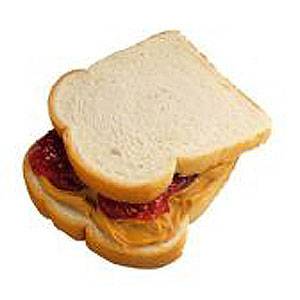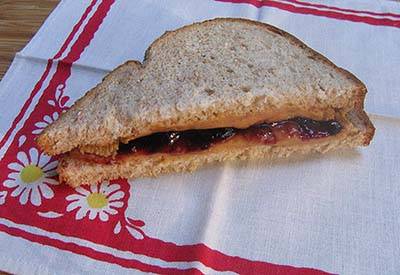
In my grade school, if you finished your school lunch and were still hungry, you could get a peanut butter and jelly sandwich. It was made with squishy white bread, government surplus peanut butter, and vaguely grape-like jelly. If anything, it was incentive to eat more slowly.
The PBJs my mother made were 180 degrees away from what I could get at school. For starters we weren’t allowed to have white bread in the house unless it was homemade. My mother didn’t believe that substances that could double as modeling clay were really bread. It didn’t matter what the label said and how much we begged for the bread with the balloons on the wrapper, she literally wasn’t buying it. Not to mention that bread that can barely take cold butter is hardly a match for peanut butter, so our PBJs were invariably on cracked wheat and whole wheat bread.

With wild black raspberries, red raspberries, blueberries, a strawberry patch, a peach tree, and our own grape vines, there was no need for store-bought jam and jelly. My mother canned dozens of jars of the real deal which were stored in the pantry in the basement of the farm house.
The only thing my mother didn’t make in the PBJ was the peanut butter. Food processors were not prevalent in those days, and making peanut butter using a meat grinder quite a bit more time consuming and messier. So we made do with what we found in the store.
Until last week, I had never made my own peanut butter, either. Having East Wind crunchy in bulk at Common Ground Food Coop in Urbana was hardly incentive. It scores well for peanut taste in national tests and is made by a cooperative community in the Ozarks. What’s not to love?
Turns out one of the biggest obstacles to making your own peanut butter is getting good peanuts. Often, the peanuts on store shelves can be two years old. But last week, my friend Susan gave me three pounds of freshly roasted Virginia peanuts that were crisp and crunchy, and unlike any peanuts I’d had before. So I took Food Network chef Alton Brown’s advice and plopped 15 ounces of them in the food processor with a tablespoon and a half of oil and pulsed them into peanut butter. He suggests adding a teaspoon of salt and a teaspoon and a half of honey. Of course, the latter is gilding the lily if you are going to eat the peanut butter with jam or jelly.
If you do find some fresh tasting in-shell peanuts, you can roast them using Brown’s method. He recommends making peanut butter with Spanish peanuts because their higher oil content will make a smoother paste. But, if you’re use to eating natural peanut butter, you can use Valencia or Virginia peanuts. You’ll need about two pounds of in-shell peanuts to make a batch of peanut butter. Brown recommends removing the skins by rubbing them against each other over a salad spinner. But you can just as easily rub them in an old terry towel. Don’t worry if you don’t remove every last bit of skin from the peanuts. If you look closely at East Wind, you’ll see that it is flecked with peanut skins.
Try making your own peanut butter just once and you’ll be wistful for all that your school lunches could have been.








